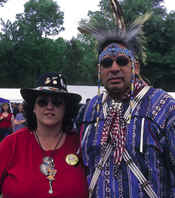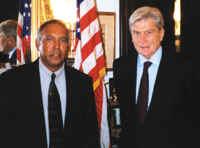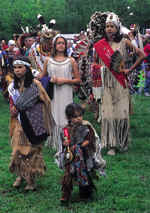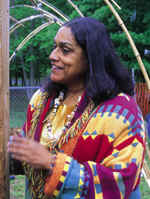Virginia's
First People
Virginia's
Indian tribes were the first to welcome our nation's founding
fathers
to
a strange New World. In a sad irony, they are among the last to gain
federal
recognition.
by
Emily Grey, Contributing Writer
The healing aroma of burning sage, sweet grass, and
wood chips wafted throughout Chickahominy tribal grounds. Drums thundered
as chiefs, bearing the American and tribal flags, marched into a
sanctified circle.
Following a prayer and the tribes� anthem, a
spirited festival began. Children and adults adorned in colorful regalia,
decorated in beads, feathers, hides, and shiny medallions, danced
rhythmically and soulfully. Some participants sang poignantly, expressing
their love for the Creator and nature.
This celebration, held in Charles City County on May
4 and 5, 2002, not only welcomed spring, it was the first occasion in 400
years that six Virginia Indian tribes had convened in a joint powwow.
�The last time our people came together as a
nation, the Powhatan Confederacy of Virginia consisted of 32 tribes with
over 14,000 people,� said Powhatan Red Cloud Owen, Chickahominy
tribesman and chairman of the historic powwow gathering. �This powwow
will be our rebuilding of what was once a great nation.�
It was also a historic first as the Monacan Indian
Nation from Virginia�s Piedmont joined eastern tribes in the festivity.
This event was one of several fundraising efforts by VITAL (Virginia
Indian Tribal Alliance for Life). This lobbying group formed in May, 2001,
to obtain federal recognition for participating Virginia Indian tribes.
�I am overwhelmed,� Mary Wade, chairperson of
VITAL, addressed the crowd.
|

Chairperson
Mary Wade, pictured here with Powhatan Red Cloud Owen, poured her
life and soul into the the VITAL cause. |
�Spirituality is strong today.� [Ms. Wade,
who poured her life and soul into the VITAL cause, passed away in April
2003, after this story was written.]
Over 6,000 people purchased dream catchers, woven
blankets, pottery, and jewelry from various Native American vendors. Fish
sandwiches, Indian fry bread, and other refreshments fed the hungry group
who mingled with chiefs and listened to accounts about different tribes.
Nansemond tribe members demonstrated flint knapping
and ways early Indians shaped tools and weapons for survival. Women
performed everyday living activities inside a replica of a longhouse.
As the amazing pageantry closed, it rained as if to
signal a trail of tears. So far, the United States government has
recognized around 550 tribes, but not Virginia�s. Our Commonwealth�s
tribes were the first people to welcome European colonists to the New
World. It is sad that they are among the last of our nation�s Indian
tribes to be federally recognized.
FEDERAL RECOGNITION
House Resolution 2345 (the Thomasina E. Jordan Indian
Tribes of Virginia Federal Recognition Act) was introduced in Congress in
2001. [It was re-introduced in 2003 by Rep. Jim Moran as H.R. 1938, and in
the Senate by Sen. George Allen as S.1423, co-sponsored by Sen. John
Warner.] An honorary member of the Chickahominy and Nansemond tribes,
Jordan�s mission was to advance the American Indians of Virginia.
Appointed by Governor Allen, she served as chairperson of the Virginia
Council on Indians until her final bout with cancer.

Ben
Adams, member of the Upper Mattaponi people, confers with U.S.
Senator John Warner on federal recognition for Virginia tribes. |
Why is federal recognition important? This special
status provides scholarships for young Indian children, health care for
the elderly, and other bonuses.
It is difficult and time-consuming to qualify for
this acknowledgment. Painstaking records, histories, and genealogies of
each tribe must be proffered to proper governmental authorities. Sponsors
of H.R. 2345 include Representatives Jim Moran, Rick Boucher, Jo Ann
Davis, Tom Davis, Edward Schrock, Bobby Scott, and Randy Forbes.
VIRGINIA-RECOGNIZED TRIBES
Our state formally recognizes the following eight
tribes. All except the latter two are seeking federal recognition.
CHICKAHOMINY
|

The
powwow held in Charles City County in 2002 marked the first
occasion in 400 years that six Virginia tribes convened in a joint
celebration. |
When Jamestown was founded, munguy or �great men�
governed this tribe who lived in villages along the James and Chickahominy
rivers to the center of New Kent County. As the English settlement grew,
the Chickahominy were driven from their homeland and subsequent villages.
Gradually, they migrated back to New Kent and then Charles City County.
They purchased land between Williamsburg and Richmond and established
Samaria Baptist Church, where an annual fall festival and powwow are held.
Today, like many other tribes, an elected chief,
assistant chief, and a council of men and women serve as leaders.
Approximately 750 Chickahominy people reside within five miles of the
Tribal Center. Several hundred more live in other parts of the United
States.
8200 Lott
Cary Rd.
Providence
Forge, VA 23140
CHIEF:
Stephen R. Adkins
|

Over
6,000 people purchased dream catchers, woven blankets, pottery,
and jewelry from various Native American vendors like this one
during the two-day powwow. |
EASTERN CHICKAHOMINY
Once a part of the Chickahominy tribe, about 150
people regrouped for religious, educational, and benevolent purposes. This
incorporated non-taxable organization is supported through dues-paying
members and contributions. They are located in New Kent County about 25
miles east of Richmond.
1211 Indian
Hill Lane
Providence
Forge, VA 23140
CHIEF: Marvin
Bradbury
MONACAN
Amherst County�s Bear Mountain has been home to the
Monacans for over 10,000 years. In 1607, they and their allies, the
Mannahoacs, ruled the regions between the fall line of the rivers near
Fredericksburg and Richmond, west to the Blue Ridge Mountains. The
Monacans, outside the original Powhatan Empire, represent the Siouan
culture and language system.
The current 1,400 members are striving to save their
heritage and customs. Their ancestral museum and cultural center is
located at St. Paul�s Episcopal Mission. In 1995, the Episcopal Diocese
returned the land to the tribe. Subsequently, the Monacans purchased over
100 acres and two additional parcels. With grants, they initiated an
elders program, tribal scholarship fund, and a cultural education program.
They have partnered with Natural Bridge to construct an interpretive
village depicting Monacan culture to the 1700s.
P.O. Box 1136
Madison
Heights, VA 24572
CHIEF:
Kenneth Branham
NANSEMOND
In 1607, this 1,200-member tribe lived in the Reids
Ferry area near Chuckatuck, or the present-day City of Suffolk. Their king
resided near Dumpling Island where he kept his treasure houses. After
English raids, the Nansemonds relocated several times and sold their final
reservations in 1791-1792. Still located in the Chesapeake/Suffolk area,
the tribe holds monthly meetings at 1850-founded Indiana Methodist Church.
The 300 tribal members are planning a center/museum and living history
venue on ancestral lands by the Nansemond River.
P.O. Box 2515
Suffolk, VA
23432
(www.nansemond.org)
CHIEF: Barry
W. Bass
RAPPAHANNOCK
In 1608, this tribe first greeted Captain John Smith
at their Kingstowne, �Cat Point Creek� on the Rappahannock River�s
banks. There were 13 villages on the south side and two on the north. In
the late 1600s, one reserve was formed when the tribe was moved away from
the river. Around 1705, they were pushed from Portabago Indian town and
relocated at Indian Neck in King and Queen County. This area between the
Mattaponi and Rappahannock rivers was their winter hunting grounds.
Descendants have remained at this locale.
From the late 1800s to the 1950s, the Smithsonian
conducted field studies of this tribe. To formalize their tribal
government, the Rappahannocks incorporated with Virginia in 1921.
In 1995, they commenced building a cultural center
targeted for completion by 2007, the 400th anniversary of America. In
1998, the tribe elected Chief G. Anne Richardson, the first woman chief
since the 1700s. They also purchased 119.5 acres to establish a housing
development and retreat center.
Rappahannock
Cultural Center
HCR 1, Box
402
Indian Neck,
VA 23148
CHIEF: G.
Anne Richardson
UPPER MATTAPONI
The Upper Mattaponi people have a long history of
residing on the upper reaches of the Mattaponi River in King William
County. From 1702 until 1727, James Adams, the official interpreter of the
British to the Chickahominy and Mattaponi, owned land on Acquinton Creek,
just a few miles from the home of the Upper Mattaponi. During the 1800s so
many had the last name Adams, they were known as the Adamstown Band. In
the early 1900s, because they lived so close to the river, they officially
changed their name to the Upper Mattaponi. They had their own school,
which they now use as their tribal center. It is the only public Indian
school building still existing in Virginia. Today there are over 500 Upper
Mattaponi people.
Rt. 1, Box
182
King William,
VA 23086
CHIEF:
Kenneth Adams
MATTAPONI
In 1646, this tribe commenced paying tribute to an
early Virginia governor. This tradition continues today around
Thanksgiving when the Mattaponi present game or fish and gifts to our
state�s current governor.
The 75 or so members live on a reservation dating
back to 1658. In search of outside work, many of the younger members left
their homeland, which expands along the borders of the Mattaponi River in
King William County.
Before the colonists arrived, these Indians
worshipped the Great Spirit. Now, they have their own Southern Baptist
church on the reservation.
Mattaponi
Indian Reservation
Route #2, Box
310
West Point,
VA 23181
CHIEF: Carl
Custalow
PAMUNKEY
Consisting of 10,000 people or 32 to 34 tribes, the
Pamunkey were the most powerful of the Powhatan Confederacy. Chief
Powhatan�s territory included the entire eastern coastal plain from the
North Carolina border to Washington, DC. He and his daughter, Pocahontas,
lived among the Pamunkey people.
This is one of the last of the Powhatan tribes who
have continued crafting pottery since aboriginal times. The 100 members
live on the King William County Pamunkey Indian Reservation near Lester
Manor.
Route 1, Box
2220
King William,
VA 23086
CHIEF:
�Swift Waters� Miles
THE FUTURE
In time, our state�s first American Indian Memorial
Park with a sacred circle and ceremonial center will be built in the
Tidewater area. This facility will feature a library and learning center
and focus on the past, present, and future of our first inhabitants. Old
history books provide only snippets of information about Virginia�s
First People. It benefits everyone to study accurate chronicles.
Update
Since the 2002 powwow, the six tribes seeking federal
recognition have had favorable hearings in the U.S. Senate and House of
Representatives. New bills have been introduced and progress has been
made, but there is still opposition from some Virginia Congressmen. With
Jamestown 2007 rapidly approaching, the efforts to achieve recognition
have intensified.
To learn more about this issue and the annual powwow
of Virginia�s First People contact:
VITAL
3120 Mount
Pleasant Road
Providence
Forge, VA 23141
(804)
938-3490
www.virginiaindians.homestead.com
United
Indians of Virginia
P.O. Box 224
New Kent, VA
23124
(804)
966-9830
www.UnitedIndiansVA.org